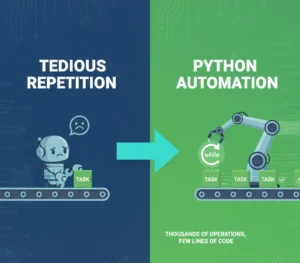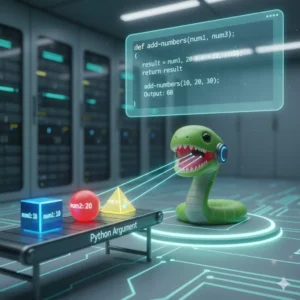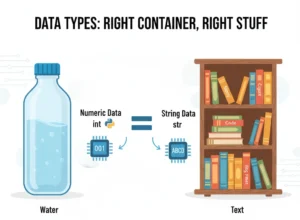Introduction
Have you ever wanted to move beyond pre-written Python scripts and create programs that can interact with people? Maybe you’ve dreamed of building a simple quiz, a calculator, or a personalized greeting tool. The secret to making your code dynamic and responsive lies in one fundamental skill:

Until now, your programs have likely used fixed data. But what if you could ask a user for their name, a number for a calculation, or a yes/no answer? This is a game-changer, and it’s easier than you think. In this guide, you’ll learn how to use Python’s input() function to capture user data, handle different data types, and write code that truly interacts with the world. Let’s unlock the power of interactive programming!
What is the input() Function?
At its core, the input() function is Python’s built-in tool for reading a line of text from the standard input (usually the keyboard). It’s like your program’s way of asking a question and patiently waiting for an answer.
When you call input(), your program pauses, a cursor blinks, and whatever the user types—until they press Enter—is captured by the function.
Let’s see it in its simplest form. Open your Python IDLE or any code editor and try this:
# The most basic use of input()
input()When you run this line, the program will seem to freeze. It’s actually waiting. Type your name and press Enter. You’ll see something like this in the console:
'your_name'Notice the quotes? This is our first crucial lesson: the input() function always returns data as a string (text), even if the user types a number.
Storing User Input in Variables
Typing input() alone isn’t very useful because we lose the data as soon as it’s entered. To actually use the input, we need to store it in a variable. This is like giving the user’s answer a label so we can refer to it later in our code.
Here’s how you do it:
# Store the input in a variable named 'name'
name = input()
print(name)When you run this code:
- The program waits for you to type something.
- You type, for example, “Alice” and press Enter.
- The string “Alice” is stored in the variable
name. - The
print(name)statement then displays the value, showingAlice.
This is the foundation of all user interaction in Python: variable = input().
Making Your Program User-Friendly with Prompts
A blinking cursor can be confusing. A good program always tells the user what to do. Fortunately, the input() function lets you provide a prompt—a message that displays before the program waits for input.
You simply pass the prompt message as a string inside the parentheses.
# Using a prompt to guide the user
user_name = input("Please enter your name: ")
print("Hello, " + user_name + "! Nice to meet you.")Now, when you run it, the user sees a clear instruction:
Please enter your name: After they type their name and press Enter, the program will print a friendly, personalized greeting. This small step makes your program infinitely more professional and easy to use.
Converting Input to Numbers: Integers and Floats
Since input() always gives us a string, what happens when we need a number for a calculation? Let’s see the problem first.
# This will cause an error because you can't add two strings mathematically.
a = input("Enter a number: ") # User types '5'
b = input("Enter another number: ") # User types '10'
sum = a + b
print(sum)You might expect 15, but you’ll get 510! Python simply glued the two strings together.
To fix this, we need to convert the string to a number. We use Python’s type conversion functions: int() for whole numbers and float() for decimal numbers.
Method 1: Convert in a Separate Step
# Step 1: Get input as a string
a_input = input("Enter a number: ") # '5'
# Step 2: Convert the string to an integer
a_number = int(a_input)
b_input = input("Enter another number: ") # '10'
b_number = int(b_input)
sum = a_number + b_number
print("The sum is:", sum) # The sum is: 15Method 2: Convert Immediately (More Efficient)
You can wrap the input() function inside an int() or float() function to convert the data the moment it’s received.
# Convert the input to an integer immediately
i = int(input("Please enter the first number: "))
j = int(input("Please enter the second number: "))
k = i + j
print("The result of i + j is:", k)This is the most common and efficient way to handle numerical input. The process works the same for float():
# Converting input to a float for decimal numbers
price = float(input("Enter the product price: "))
tax = price * 0.08
print("The sales tax is:", tax)Converting to Other Data Types
The same conversion principle applies to other data types, like booleans (bool()). However, be cautious! For booleans, only an empty string ("") converts to False. Every other non-empty string converts to True.
# Converting input to a boolean
user_truth = bool(input("Is it true? (Type anything): "))
print("The boolean value is:", user_truth)A Complete, Interactive Example
Let’s put everything together into a simple program that tells a story.
# A simple interactive story
print("--- Let's Create a Story! ---")
name = input("Enter a character's name: ")
age = int(input("Enter their age: "))
quest = input("What is their quest? ")
speed = float(input("How fast can they run (in km/h)? "))
print("\nHere is your story:")
print(name + ", a brave " + str(age) + "-year-old, embarked on a quest to " + quest + ".")
print("Traveling at a blistering " + str(speed) + " km/h, they were sure to succeed!")A Word on Errors
What if a user is asked for a number but types “hello world”? The int() function won’t know what to do and will crash your program with a ValueError. Handling these errors gracefully is a critical next step, which we cover in our advanced lessons on error handling with try/except blocks.
Ready to Go from Basics to Pro?
You’ve just taken a huge leap forward by learning how to make your Python programs interactive. This is the foundation for building everything from simple calculators to complex web applications. If you’re enjoying this journey and want to build a solid, professional skillset, structured learning is the key.
Moving beyond basics like error handling, data structures, and real-world project building can be challenging on your own. Our comprehensive course is designed to guide you step-by-step, turning these initial concepts into marketable skills.
If you’re serious about mastering Python, check out our pre-recorded python comprehensive video course.
Conclusion
Congratulations! You now know how to capture user input in Python using the input() function, store it in variables, and guide users with clear prompts. Most importantly, you’ve mastered the essential skill of converting string input into other data types like integers and floats, unlocking the true potential for calculations and dynamic programs. Remember, practice is the key to cementing this knowledge. Open your editor, try the examples, and then start inventing your own little interactive programs. The world of coding just got a whole lot bigger for you!
Common Questions About Python User Input
Why does input() always return a string?
This is a design choice that simplifies the function. It treats all input as text first, giving you, the programmer, full control to convert it to the specific data type your program needs, whether it’s a number, boolean, or something else.
How can I prevent errors if a user types text when I expect a number?
The best practice is to use a try and except block. This allows your code to “try” to convert the input and “except” any errors, letting you prompt the user to try again instead of crashing the program.
Can I take multiple inputs in a single line?
Yes, you can! You can use methods like .split() on the input string to separate multiple values. For example, data = input("Enter two numbers: ").split() would allow a user to type “5 10”, and data would become the list ['5', '10'].














